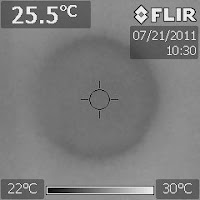 I have blogged about some intriguing IR images when a piece of paper is placed on top of a cup of water. The part of paper above the water warms up (Figure 1) because of the release of latent heat of condensation of water vapor to its underside. If you want to reproduce this effect, note that the shallow the cup, the more pronounced the effect (I used a lid and turned it over to use as a shallow cup).
I have blogged about some intriguing IR images when a piece of paper is placed on top of a cup of water. The part of paper above the water warms up (Figure 1) because of the release of latent heat of condensation of water vapor to its underside. If you want to reproduce this effect, note that the shallow the cup, the more pronounced the effect (I used a lid and turned it over to use as a shallow cup). In these IR images, I chose the gray coloring mode. So white represents the hottest and black the coldest.
In these IR images, I chose the gray coloring mode. So white represents the hottest and black the coldest.
If we leave the paper for a couple more minutes, the part of paper actually becomes cooler (Figure 3). So what is going on?
My theory is that water molecules have percolated through the paper, which is porous (having a lot of small holes), to the other side and evaporate from there. So we are seeing the evaporative cooling effect from the above side of the paper. Figure 4 presents evidence that supports this theory. If we shift the paper a little bit, we will see three zones with three different temperatures. The coolest zone shows the effect of evaporative cooling from both sides. The overlap zone shows the effect of evaporative cooling from only the above side. And the warmest zone shows the effect of condensation heating from the underside. (Is this pattern beautiful?!)
Figure 5 shows the comparison between direct evaporation (the dark area on the left) and permeation-then-evaporation (the less dark area on the right). The result indicates that the paper did impede evaporation, even though its micro pores allow water to percolate through.
This follow-up study shows that even a humble experiment like placing a piece of paper atop water has many surprises that reveal the richness of science, which all become transparent under an IR camera. I will blog more surprises derived from this experiment later.

